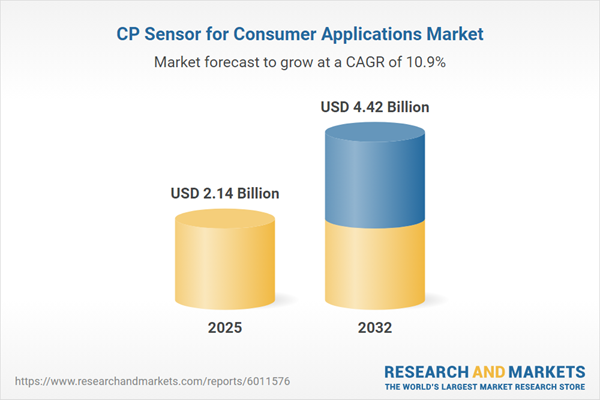Speak directly to the analyst to clarify any post sales queries you may have.
The contact pressure sensor for consumer applications market is rapidly evolving as connectivity, miniaturization, and smart integration transform consumer electronics, medical devices, and home automation. Senior decision-makers seeking to stay ahead in a digitally converging sector will benefit from a clear understanding of these changing dynamics and technology trends.
Market Snapshot: Contact Pressure Sensor for Consumer Applications Market
The CP Sensor for Consumer Applications Market grew from USD 1.93 billion in 2024 to USD 2.14 billion in 2025. It is expected to continue growing at a CAGR of 10.86%, reaching USD 4.42 billion by 2032. This growth is propelled by advances in miniaturized sensor fabrication, seamless connectivity across devices, and increased demand for automated comfort and diagnostics in multiple end-use domains.
Scope & Segmentation
- Application: Automotive interiors, medical devices, blood pressure monitors, digital thermometers, smart home appliances, smart HVAC systems, smart refrigerators, smart security systems, smartphones, wearables, fitness bands, and smartwatches.
- Sensor Technology: Capacitive pressure, optical pressure, piezoelectric pressure, and thermal pressure solutions addressing diverse operational and design requirements.
- End User: Aftermarket players retrofitting legacy products, do-it-yourself innovators, and original equipment manufacturers embedding sensors into new product lines.
- Sales Channel: Brick-and-mortar distributors supporting established clients, direct sales channels for enterprise contracts, distributor partnerships for broad geographic reach, and online retailers for prototyping and small volume orders.
- Regional Coverage: Americas (including the United States, Canada, Mexico, Brazil, Argentina, Chile, Colombia, Peru), Europe, Middle East, and Africa (covering the UK, Germany, France, Russia, Italy, Spain, Netherlands, Sweden, Poland, Switzerland, United Arab Emirates, Saudi Arabia, Qatar, Turkey, Israel, South Africa, Nigeria, Egypt, Kenya), and Asia-Pacific (China, India, Japan, Australia, South Korea, Indonesia, Thailand, Malaysia, Singapore, Taiwan).
- Companies Analyzed: Texas Instruments, STMicroelectronics, Infineon Technologies, Microchip Technology, Analog Devices, NXP Semiconductors, Cypress Semiconductor, ROHM, Silicon Laboratories, Goodix Technology.
Key Takeaways for Senior Decision-Makers
- Integrating advanced contact pressure sensors enables robust user experiences and predictive maintenance across smart devices, wearables, and home appliances by delivering real-time, context-rich insights.
- Collaborations among materials scientists, electronics engineers, and software developers are accelerating the adoption of multi-material substrates, embedded AI analytics, and edge computing capabilities.
- Standardization and modular sensor assemblies are simplifying device interoperability, supporting unified control frameworks in smart home and commercial ecosystems.
- Strategic supplier diversification and regionally distributed manufacturing hubs are becoming essential to maintain supply chain resilience amid evolving trade regulations.
- Pressure sensing is moving beyond traditional control feedback, serving strategic roles in safety interlocks, health diagnostics, and immersive haptics for evolving consumer demands.
Tariff Impact: Navigating Regulatory and Trade Shifts
The 2025 United States tariffs on contact pressure sensors have led manufacturers to reevaluate sourcing strategies and accelerate regional manufacturing. Companies face higher material input costs, prompting exploration of tariff engineering and volume commitments to maintain competitiveness. Agile supply chains and adaptive product architectures are vital as regulatory and duty landscapes become increasingly complex.
Methodology & Data Sources
This research leverages in-depth interviews with R&D leaders, supply chain executives, and strategists from top sensor and electronics manufacturers. Analysis includes technical standards reviews, patent mapping, and regulatory filings. Robust quantitative validation through supply chain modeling and expert panels ensures accuracy and actionable market insights.
Why This Report Matters
- Enables strategic alignment with emerging sensor technologies and multi-industry IoT trends for gaining competitive advantage.
- Informs sourcing, manufacturing, and partnership decisions amid regulatory uncertainty and global trade shifts.
- Supports proactive roadmap development by mapping application trends and end-user demands across geographies.
Conclusion
The contact pressure sensor for consumer applications market is advancing through innovation, supply chain adaptation, and cross-industry collaboration. Leaders who shape strategies around resilience and technology integration are well-positioned to harness this expanding opportunity.
Additional Product Information:
- Purchase of this report includes 1 year online access with quarterly updates.
- This report can be updated on request. Please contact our Customer Experience team using the Ask a Question widget on our website.
Table of Contents
3. Executive Summary
4. Market Overview
7. Cumulative Impact of Artificial Intelligence 2025
Companies Mentioned
The companies profiled in this CP Sensor for Consumer Applications market report include:- Texas Instruments Incorporated
- STMicroelectronics N.V.
- Infineon Technologies AG
- Microchip Technology Incorporated
- Analog Devices, Inc.
- NXP Semiconductors N.V.
- Cypress Semiconductor Corporation
- ROHM Co., Ltd.
- Silicon Laboratories Inc.
- Goodix Technology Inc.
Table Information
| Report Attribute | Details |
|---|---|
| No. of Pages | 197 |
| Published | October 2025 |
| Forecast Period | 2025 - 2032 |
| Estimated Market Value ( USD | $ 2.14 Billion |
| Forecasted Market Value ( USD | $ 4.42 Billion |
| Compound Annual Growth Rate | 10.8% |
| Regions Covered | Global |
| No. of Companies Mentioned | 11 |









